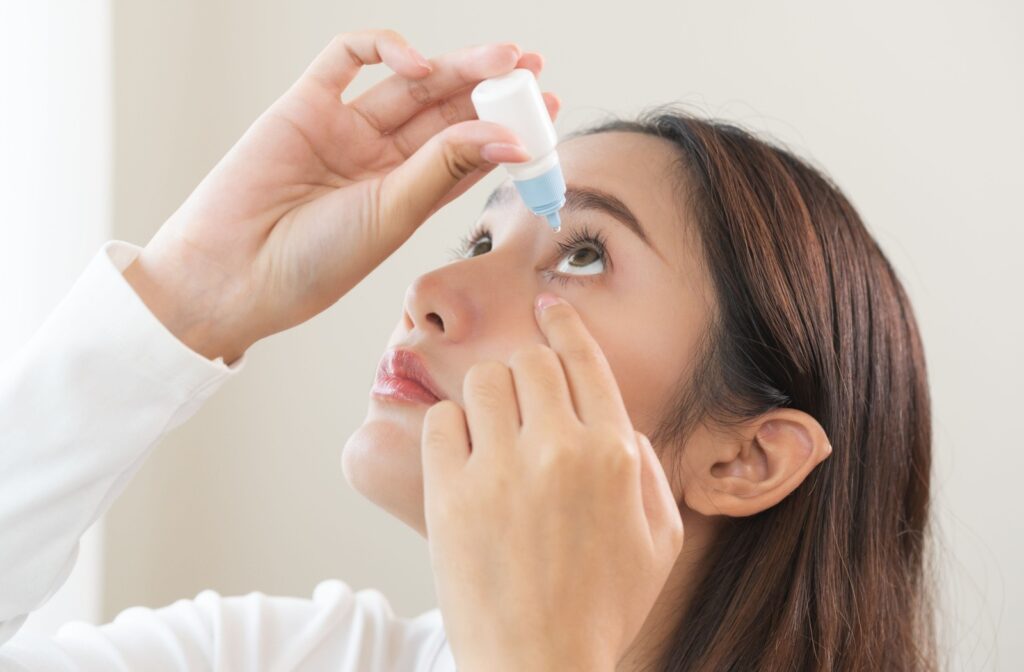You may feel a gritty, burning, or stinging sensation in your eyes after a long day at the computer or in a windy environment. This discomfort is a common sign of dry eye.
While permanent vision loss from dry eye is very rare, severe and untreated cases can lead to complications that seriously affect your vision. That’s why we recommend coming in for an eye exam, so that we can find a path forward for your eye health.
What It Feels Like to Have Dry Eyes
Dry eye happens when your tears don’t provide enough lubrication for your eyes, a condition which the National Eye Institute describes as complex and common. This can be frustrating and affect your day-to-day activities. The discomfort can range from slightly annoying to a constant problem that disrupts your life.
Common Signs & Symptoms
- A scratchy or gritty feeling, like something is in your eye
- Stinging or burning sensations
- Redness & irritation
- Sensitivity to light
- Blurry vision, especially when you read
Daily Triggers for Dry Eye Discomfort
Many parts of modern life can contribute to dry eye symptoms. Staring at screens for hours reduces how often you blink, and environments with dry air from heating or air conditioning can also make symptoms worse.
The Connection Between Severe Dry Eye & Vision
It’s natural to be concerned about your long-term eye health. While uncommon, severe and untreated chronic dry eye can lead to complications that damage the eye’s surface—potentially affecting your vision. Proper care is key to protecting your sight.
How Dry Eyes Affect Your Cornea
Your tears create a smooth surface on your cornea—the clear front part of your eye—that is important for clear vision. Without a healthy tear film, the cornea can become damaged, rough, and inflamed. These corneal injuries can in turn cause blurriness and discomfort.
What Are the Dangers of Dry Eyes?
When the cornea is not protected by tears, it becomes more vulnerable to infection. In serious cases, this can lead to corneal ulcers, which are open sores on the cornea. These ulcers can cause scarring and vision loss if not treated.
Understand Dry Eye Severity
Dry eye is different for everyone. It can be a mild, temporary issue for some or a persistent, chronic condition for others. The right approach to relief depends on the severity of your symptoms and their causes.
Mild vs. Chronic Dry Eye
Mild dry eye might only bother you in certain situations, like on an airplane or in a very dry room. Chronic dry eye involves more constant symptoms that don’t go away easily. Often, this is caused by underlying issues like Meibomian gland dysfunction (MGD).
Find Relief for Your Dry Eye Symptoms

Managing dry eyes often requires more than basic at-home care. While over-the-counter drops and lifestyle adjustments can offer temporary relief, they don’t address the underlying causes of chronic or moderate-to-severe dry eye. For long-lasting improvement, targeted professional treatments are often the most effective and reliable option.
Why Advanced Treatment Matters
Many people who struggle with recurring dryness have already tried artificial tears, humidifiers, or screen breaks with only minimal improvement. When symptoms continue to impact your comfort or ability to wear contact lenses, it’s a sign that your eyes may need a more comprehensive treatment approach guided by your eye doctor.
IPL Therapy for Dry Eye (Our Most Effective Option)
Intense Pulsed Light (IPL) therapy has become one of the most successful and highly recommended treatments for dry eye caused by meibomian gland dysfunction (MGD)—one of the most common root causes of dryness. IPL gently applies controlled pulses of light to the skin around the eyes, helping:
- Reduce inflammation
- Melt and release hardened oil trapped in the glands
- Restore natural tear film stability
- Improve long-term comfort and tear production
Many patients experience significant relief after just a few sessions, and satisfaction rates are consistently high. Because IPL targets the source of the problem—not just the symptoms—it offers meaningful, lasting improvement for people who haven’t found success with drops or home remedies.
Other Professional Treatment Options
Alongside IPL, your doctor may recommend other therapies such as prescription eye drops, meibomian gland expression, or specialty contact lenses designed to retain moisture. These options can be combined to create a personalized treatment plan based on your specific symptoms and lifestyle.
Your Outlook with Dry Eye Management
With a consistent management plan, most people with dry eye can reduce their discomfort and protect their eye health. The goal is to keep your eyes lubricated to maintain clear, comfortable vision.
Is Vision Loss from Dry Eyes Reversible?
In many cases, vision problems like blurriness are temporary and improve once the eye’s surface is properly lubricated again. If corneal damage has occurred, treatment can help prevent further issues and support the healing process. In-office therapies like IPL and radiofrequency can also restore proper gland function.
Can You Drive If You Have Dry Eyes?
Blurry vision or excessive tearing from dry eye can make driving difficult. Managing your symptoms with lubricating drops before you drive can help. Reducing glare with sunglasses can also improve your comfort and safety on the road.
Next Steps for Clear & Comfortable Vision
You don’t have to live with constant eye discomfort. Taking your symptoms seriously is the first step toward relief. As your eye doctor in Wichita, we can provide you with a clear diagnosis and a personalized path forward.
Your vision is important, and our team at The Eye Gallery is here to help you protect it. We can work with you to find the cause of your dry eye and create a management plan tailored to your lifestyle. Schedule a visit with us today and take the first step toward lasting comfort.




